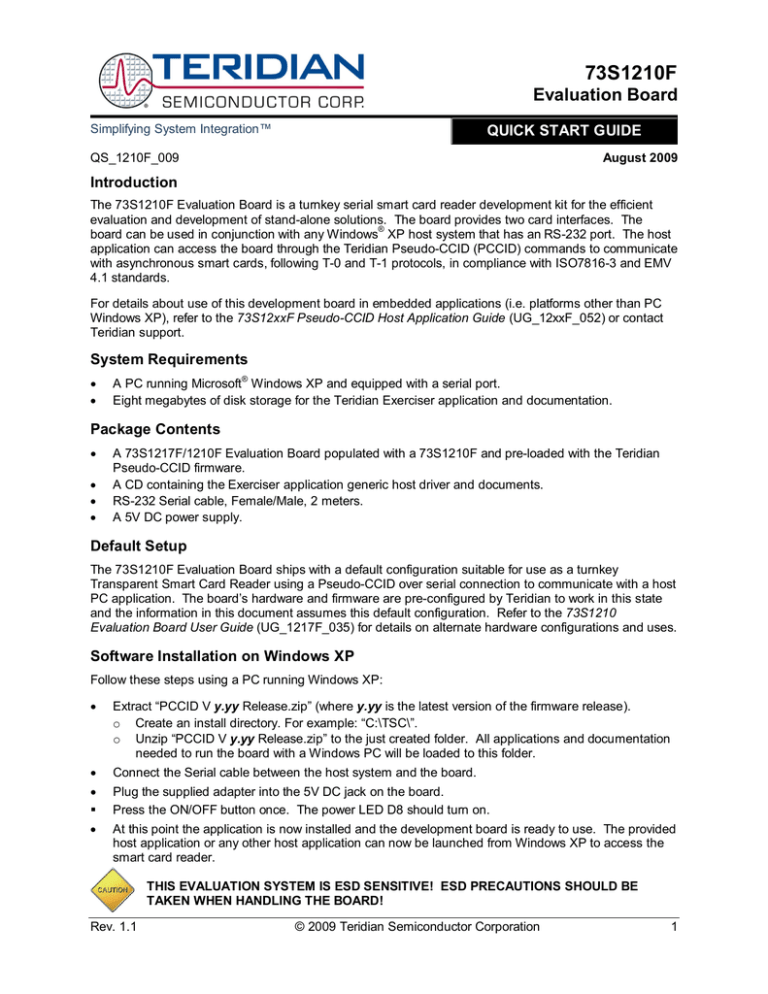
73S1210F
Evaluation Board
Simplifying System Integration™
QUICK START GUIDE
QS_1210F_009
August 2009
Introduction
The 73S1210F Evaluation Board is a turnkey serial smart card reader development kit for the efficient
evaluation and development of stand-alone solutions. The board provides two card interfaces. The
®
board can be used in conjunction with any Windows XP host system that has an RS-232 port. The host
application can access the board through the Teridian Pseudo-CCID (PCCID) commands to communicate
with asynchronous smart cards, following T-0 and T-1 protocols, in compliance with ISO7816-3 and EMV
4.1 standards.
For details about use of this development board in embedded applications (i.e. platforms other than PC
Windows XP), refer to the 73S12xxF Pseudo-CCID Host Application Guide (UG_12xxF_052) or contact
Teridian support.
System Requirements
•
•
A PC running Microsoft® Windows XP and equipped with a serial port.
Eight megabytes of disk storage for the Teridian Exerciser application and documentation.
Package Contents
•
•
•
•
A 73S1217F/1210F Evaluation Board populated with a 73S1210F and pre-loaded with the Teridian
Pseudo-CCID firmware.
A CD containing the Exerciser application generic host driver and documents.
RS-232 Serial cable, Female/Male, 2 meters.
A 5V DC power supply.
Default Setup
The 73S1210F Evaluation Board ships with a default configuration suitable for use as a turnkey
Transparent Smart Card Reader using a Pseudo-CCID over serial connection to communicate with a host
PC application. The board’s hardware and firmware are pre-configured by Teridian to work in this state
and the information in this document assumes this default configuration. Refer to the 73S1210
Evaluation Board User Guide (UG_1217F_035) for details on alternate hardware configurations and uses.
Software Installation on Windows XP
Follow these steps using a PC running Windows XP:
•
Extract “PCCID V y.yy Release.zip” (where y.yy is the latest version of the firmware release).
o Create an install directory. For example: “C:\TSC\”.
o Unzip “PCCID V y.yy Release.zip” to the just created folder. All applications and documentation
needed to run the board with a Windows PC will be loaded to this folder.
•
•
Connect the Serial cable between the host system and the board.
Plug the supplied adapter into the 5V DC jack on the board.
Press the ON/OFF button once. The power LED D8 should turn on.
•
At this point the application is now installed and the development board is ready to use. The provided
host application or any other host application can now be launched from Windows XP to access the
smart card reader.
THIS EVALUATION SYSTEM IS ESD SENSITIVE! ESD PRECAUTIONS SHOULD BE
TAKEN WHEN HANDLING THE BOARD!
Rev. 1.1
© 2009 Teridian Semiconductor Corporation
1
73S1210F Evaluation Board Quick Start Guide
QS_1210F_009
Demonstration Host Application
Included on the CD is a demonstration application named “TSCP-CCID.exe” which is located in the
“x:\yyy\ \PCCID Vz.zz Release\Host Applications\Windows App\App\Bin\Release” directory (where x
refers to the drive, yyy refers to the directory the installation .zip file was expanded to and z.zz is the
latest version of the firmware release). This is a host application that allows:
•
Smart card activation and deactivation, in ISO or EMV mode.
•
•
Smart card APDU commands to be exchanged with the smart card inserted in the board.
Starting a test sequence in order to test and evaluate the board performance against an EMV test
environment.
Run TSCP-CCID.exe to execute the host demonstration application. At this point the application window
should appear. For additional information regarding the use of the Teridian Host application, refer to the
Pseudo-CCID Host GUI Users Guide (UG_12xxF_037).
Integration in an Embedded System
The 73S1210F Evaluation Board can also be connected to a host microprocessor in an embedded
architecture, like in Point-of-Sales terminals, solid-state utility meters and digital Set-Top Boxes. In such
cases, a software Pseudo-CCID driver must be integrated within the host processor embedded software.
The Teridian CD provided with this Development Board includes the ANSI C source code of the Teridian
generic driver that will allow seamless integration into virtually and processor and operating system. For
additional information, refer to the 73S12xxF Pseudo-CCID Host Application Guide (UG_12xxF_052).
© 2009 Teridian Semiconductor Corporation. All rights reserved.
Teridian Semiconductor Corporation is a registered trademark of Teridian Semiconductor Corporation.
Simplifying System Integration is a trademark of Teridian Semiconductor Corporation.
Microsoft and Windows are registered trademarks of Microsoft Corporation.
All other trademarks are the property of their respective owners.
2
Rev. 1.1

